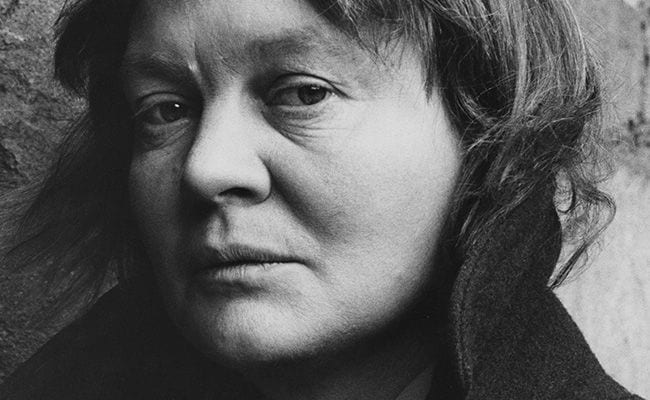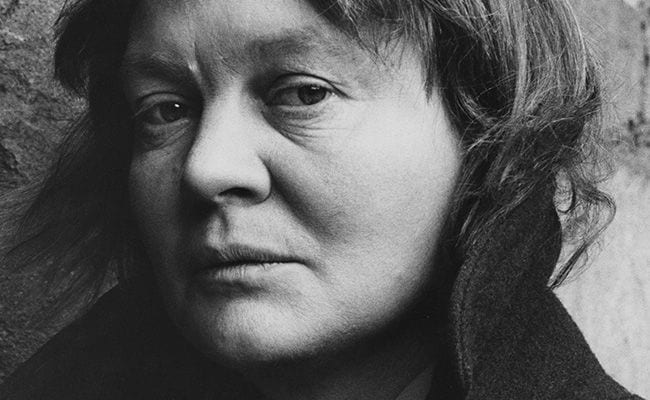
“I think I am probably better at absence than you are. I have had and indeed have an awful lot of it in my life,” Iris Murdoch wrote to her friend Philippa Foot in June 1968, “And I can live in letters” (p. 368). Living on Paper: Letters From Iris Murdoch 1934 – 1995 bears out at least the latter part of the author’s self-assessment. This hefty volume, edited by Anne Rowe and Avril Horner, collects a range of Murdoch’s correspondence over 60 years, taking her from schoolgirl to Oxford student to celebrated novelist and philosopher through to her final Alzheimer’s-afflicted years (the latter already controversially immortalised in her husband John Bayley’s memoirs and in Richard Eyre’s Judi Dench-starring film).
The years since Murdoch’s death in 1999 haven’t lacked for biographical portraits of her and, as director of Kingston University’s Iris Murdoch Archive Project, Rowe has been tireless in putting Murdoch studies firmly back on the academic map after the dip in Murdoch’s reputation in the ’80s. Living on Paper represents something fresh, though: a composite picture of the author formed through her own words to friends, lovers, colleagues, and students. As the editors’ argue in the Introduction: “Murdoch’s letters constitute a distinct aspect of her writing persona: they are not merely an addition to her oeuvre, but an integral part of it, both illuminating and complicating our understanding of her philosophy and her fiction” (p.xviii).
In his excellent biography Iris Murdoch: A Life (2001) Peter Conradi sums up what letter-writing signified for Murdoch: “Face-to-face communication, except with remarkably few close friends, could be shy and inhibited. On paper, being a writer, she experienced freedom” (Conradi, p.201). Murdoch would spend up to four hours a day on correspondence, writing to fans and casual acquaintances as well as intimate friends. That Living on Paper doesn’t manage to be fully comprehensive, despite its bulk, testifies both to Murdoch’s insatiability as a correspondent (“I always [reply] unless they are mad or spiteful”, (p.420) and to the very varied relationships that she sustained over her lifetime.
There are some fairly startling omissions in the volume; no letters to Bayley, for one, and the editors note that some correspondence was “destroyed or … unavailable at the time of writing” (p.xix). Such gaps necessitate a certain amount of editorial “filling in”, but the collection is carefully structured in eight chronological sections, with an introduction to each that usefully sketches out the main events and relationships covered.
Here, then, is Murdoch’s life as lived through letters: incomplete, partial and fragmentary, yet no less absorbing for that. Nonetheless, since Murdoch was a rather private individual with a tendency to compartmentalise her life — a person who once wrote (marvellously) that “there are not many people whom one wants to know one” (Conradi 2001, p.515) — it’s hard not to feel a certain uneasiness about this personal correspondence being in the public domain. Early responses to the collection have been mixed, although most reviewers have focused less on the ethics of the endeavour than on blunt moral judgements regarding the more salacious “revelations” about Murdoch’s behaviour included here.
As is known, Murdoch continued to pursue intense, sometimes erotically-tinged intimacies with both men and women following her marriage to Bayley in 1956, and it’s these relationships that have (somewhat predictably) been highlighted in early reviews. “Was it nymphomania?” frets The New York Times embarrassingly, claiming (inaccurately) that “[t]he central focus [of this selection of letters] is Murdoch’s sexual career [sic].”
Other reviewers of the volume, meanwhile, have used the letters as evidence with which to indict Murdoch on charges other than sexual promiscuity (laziness and emotional incontinence being but two examples), leading to the strong sense that it’s not so much the collection but rather Murdoch’s conduct that are coming under review.
Maybe Murdoch’s status as a moral philosopher makes such commentaries particularly irresistible. There seems, for certain critics, a definite glee in revealing that her behaviour was sometimes less than “exemplary”, in their terms. Yet the approach is reductive, to say the least. (It’s also decidedly ironic, given that Murdoch’s own philosophy stressed the importance of overcoming lazy perceptions and diminishments of other people.) Indeed, despite one’s qualms about the invasion of privacy that the collection represents, Living on Paper is much richer and more rewarding than you would expect from these early reports.
Murdoch’s letters are diverse in tone: frequently funny and playful, often lyrical and beautiful, full of gems of perception and insight. Through them we bear witness to the forming of her intellectual interests, including her reading of Henry James (“he writes in about five dimensions, and in that gorgeous, convoluted style” (p.36)), and her immersion in European philosophy. Inevitably, the letters also touch on the massive social changes of the time and Murdoch’s responses to them (her faith in the romantic notion of “universal brotherhood” is getting tested as early as her post-war work with UNRRA), offering what one might describe as an alternative social history from the perspective of a writer, who, despite critical acclaim and popular success, was often (productively) out of step with contemporary trends.
The volume’s real value, though, lies in its illumination of the complexity of Murdoch’s identity and relationships, which, it’s clear, fed both her fiction and her thought in fruitful ways. We see Murdoch’s identity here as profoundly relational and, rather than harshly judging her, it’s more productive to note the way different correspondents draw out diverse aspects of her personality. The letters show her from multiple angles: variously bantering, serious, generous, retrograde then progressive, arrogant then painfully doubting her own abilities. Friendships fade, stall, strengthen, or reshape themselves. The fates and personalities of many others come filtered through Murdoch’s addresses to them: whether it’s her early beau Frank Thompson, an archetypal “good man” killed in the war; her ever-elusive “demon lover” Elias Canetti ; the demanding, alluring Brigid Brophy; or Lucy Klatschko, the wild child turned nun.
A stunning letter to the mathematical logician Georg Kreisel, in which Murdoch writes frankly about the complexity of her sexuality and her inability to “divide friendship from love or love from sex” (p. 347-8), may be regarded as the volume’s centrepiece. By degrees, the fraught emotionality of the earlier letters gives way to calmer expressions, as incessant travel and deep immersion in work projects lead to the Bayleys’ well known domestic disarray (“the house is in chaos and I have no time to clean it” (p.486)). Through it all, the characteristic that defines Murdoch the most, perhaps, is curiosity: an enduring, open interest in people, places, belief systems, and what she terms the “heterogeneous stuff” of life.
Virginia Woolf (not a novelist of whom Murdoch was fond) called letter-writing “the humane art”. While not without elements of self-serving exhibitionism, Murdoch’s letters fit that definition. Reaching out to (sometimes barely known) others, interested and encouraging, they may be read as expressions of what Murdoch describes to her friend Rachel Fenner as “active love” (p.251). The trajectory of Living on Paper is necessarily a poignant, even harrowing one: the text takes us from the teenage Murdoch’s exuberant “Hello!” to a school-friend to the fragmented sentences of the late correspondence that show her still trying to connect even as she succumbs to Alzheimer’s Disease. (“I think about the past and you and me in the past”, she writes, heartrendingly, to Klatschko in 1995 (p.598).)
Yet, despite such sorrow, the volume feels strangely life-affirming overall. “Thank you for so much happiness,” Murdoch writes to Philippa Foot following a joyful time together. It’s a sentiment that the responsive reader of Living on Paper firmly echoes.

